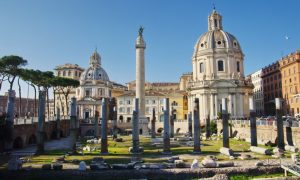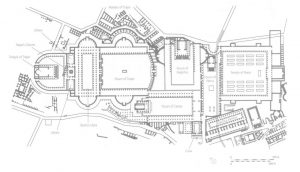Trajan’s Forum (Forum Traiani in Latin) was one of the most impressive architectural sites in ancient Rome and a popular gathering place for the people of Rome. Built entirely out of marble and standing at over 300 meters long, it was a testament to Roman power and wealth. It was named after Roman Emperor Trajan (full name Marcus Ulpius Traianus), who ruled from AD 98 to 117. He ordered it to be built using spoils from the Dacian Wars (AD 101 – 106). Designed by the architect and engineer Apollodorus of Damascus, well-known for his practical and sturdy designs, this was the last of the Imperial fora to be constructed in Rome.
Construction
Construction of the forum began around 105 and was completed in 112. It was an immense undertaking that required significant excavations. To create a massive level space as wide as two city blocks, Trajan ordered workers to remove a ridge connecting the Quirinal and Capitoline hills (the Campidoglio). Over 300,000m³ of soil and rock had to be excavated and disposed of outside the Porta Collina. The purpose of the forum was to recognize the success of Trajan’s wars against the Dacians and serve as a gathering place for the people of Rome. It was used as a venue for public speeches, festivals, and other events.
The project was attributed entirely to Apollodorus, who also accompanied Trajan in the Dacian campaign. He is mentioned as being responsible for several engineering works around the empire, including a bridge over the Danube River (known as Trajan’s Bridge) located in what is now Romania. During his reign, Trajan ordered several additional structures to be built in the area, including Trajan’s Market, Trajan’s Aqueduct, and Trajan’s Baths. These structures were all connected by a network of roads, making it easy for visitors to navigate this portion of Rome.
Physical Description
The Forum consisted of a massive portico-lined piazza measuring 300 by 185 meters. The main entrance to the forum was on its long southern side through a triumphal arch decorated with sculptures of Dacian prisoners. On the opposite end of the forum was Trajan’s Column, a triumphal column that commemorated his victory in the conquest of Dacia. Flanking the column were two libraries—one on the eastern side and the other on the western.
On the northern side of the piazza was a large basilica called the Basilica Ulpia, which used to host judicial hearings and other business activities. The southern end of the piazza was flanked by two exedrae, semi-circular spaces that were open to the sky. These were where Trajan, who loved art and architecture, used to host public ceremonies.
The forum was built entirely of marble, except for the concrete used for the foundation. All of the structures were built with several varieties of marble, except for the libraries, which were built with brick. Emperor Hadrian (ruled from 117 – 138), who succeeded him, added a temple to the deified Trajan—who was declared a god by the Senate after his death—on the northern side of the forum.
Today, the forum can still be found on the Via dei Fori Imperiali, close to the Colosseum. The most notable features of Trajan’s Forum are its colossal size, architectural grandeur, and beautiful sculptures. Although it is in ruins, the massive scale of the Forum and its different structures can still be appreciated.


